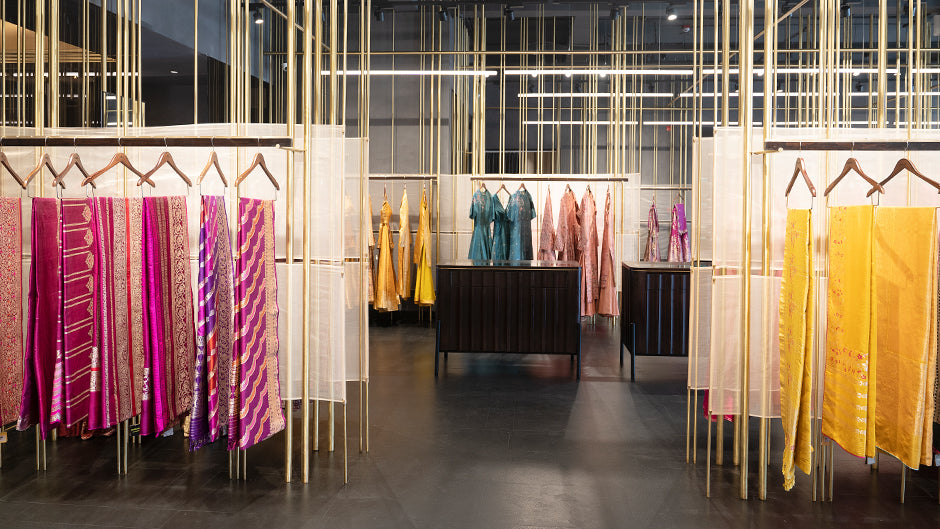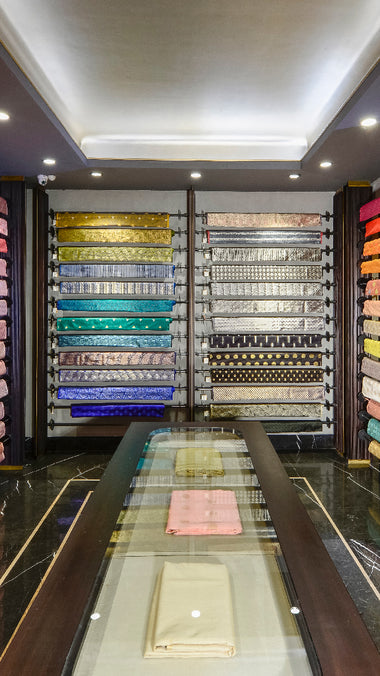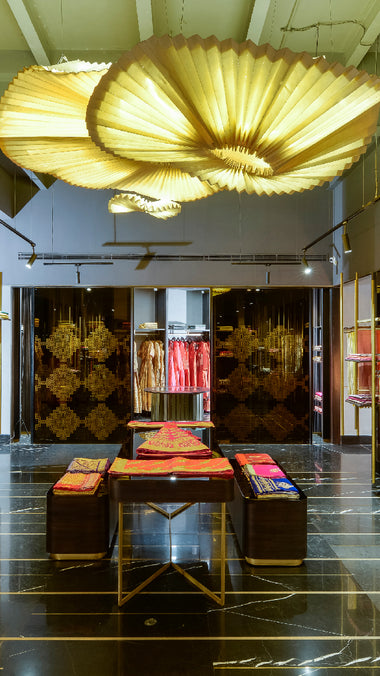Collection: Real Zari Saree
Zari Sarees

-

Handwoven Red Rose Gold Zari Saree
Regular price ₹35,975Regular priceUnit price / per₹35,975Sale price ₹35,975Fabric: Silk
Regular price ₹35,975Regular priceUnit price / per₹35,975Sale price ₹35,975 -

Handwoven Real Zari Navy Silk Saree
Regular price ₹469,975Regular priceUnit price / per₹469,975Sale price ₹469,975Fabric: Silk
Regular price ₹469,975Regular priceUnit price / per₹469,975Sale price ₹469,975READY TO SHIP -

Handwoven Real Zari Mustard Silk Saree
Regular price ₹295,975Regular priceUnit price / per₹295,975Sale price ₹295,975Fabric: Silk
Regular price ₹295,975Regular priceUnit price / per₹295,975Sale price ₹295,975READY TO SHIP -

Handwoven Real Zari Mustard Silk Saree
Regular price ₹371,975Regular priceUnit price / per₹371,975Sale price ₹371,975Fabric: Silk
Regular price ₹371,975Regular priceUnit price / per₹371,975Sale price ₹371,975READY TO SHIP -

Handwoven Real Zari Beige Silk Saree
Regular price ₹374,275Regular priceUnit price / per₹374,275Sale price ₹374,275Fabric: Silk
Regular price ₹374,275Regular priceUnit price / per₹374,275Sale price ₹374,275READY TO SHIP -

Handwoven Real Zari Rani Silk Saree
Regular price ₹469,975Regular priceUnit price / per₹469,975Sale price ₹469,975Fabric: Silk
Regular price ₹469,975Regular priceUnit price / per₹469,975Sale price ₹469,975READY TO SHIP -

Handwoven Real Zari Red Silk Saree
Regular price ₹303,275Regular priceUnit price / per₹303,275Sale price ₹303,275Fabric: Silk
Regular price ₹303,275Regular priceUnit price / per₹303,275Sale price ₹303,275READY TO SHIP -

Handwoven Real Zari Purple Silk Saree
Regular price ₹303,275Regular priceUnit price / per₹303,275Sale price ₹303,275Fabric: Silk
Regular price ₹303,275Regular priceUnit price / per₹303,275Sale price ₹303,275READY TO SHIP -

Handwoven Real Zari Mustard Silk Saree
Regular price ₹374,275Regular priceUnit price / per₹374,275Sale price ₹374,275Fabric: Silk
Regular price ₹374,275Regular priceUnit price / per₹374,275Sale price ₹374,275READY TO SHIP -

Handwoven Real Zari Yellow Silk Saree
Regular price ₹374,275Regular priceUnit price / per₹374,275Sale price ₹374,275Fabric: Silk
Regular price ₹374,275Regular priceUnit price / per₹374,275Sale price ₹374,275READY TO SHIP
Discover Ekaya’s Zari Sarees
Experience the exquisite beauty and meticulous craftsmanship of Zari sarees with Ekaya. Whether for a lavish celebration or to elevate your collection, our sarees speak volumes of timeless elegance and cultural grandeur. Discover their unparalleled allure.
How Is a Pure Zari Silk Saree Made?
Creating a pure zari silk saree requires meticulous weaving, using delicate silk and precious metallic threads made from silver or gold. This centuries-old tradition demands great expertise and effort, making it a true work of art. Let's look at the step-by-step process of crafting a pure zari silk saree. Here is an overview:
Selecting Raw Materials: The process begins with selecting high-quality silk threads for the saree base. These threads are chosen for their strength, smooth texture, and ability to absorb dyes.
Preparing the Silk Threads: The selected silk threads undergo a thorough cleaning and degumming process to remove any impurities and sericin (a natural gum) from the silk fibres. This ensures the silk is soft, lustrous, and ready for weaving.
Dyeing the Silk: The silk threads are dyed using vibrant and carefully chosen colours. This step is crucial as it determines the final look of the saree. The dyed silk threads are then left to dry.
Preparing the Zari Threads: Pure zari threads, made of either silver or gold, are prepared separately. These metallic threads are drawn, twisted, and flattened to the desired thickness. The purity of zari is often denoted by its silver or gold content, measured in karats.
Twisting and Combining Threads: The dyed silk threads and pure zari threads are twisted to form the base material for weaving. The combination of silk and zari threads creates a luxurious and textured fabric.
Setting up the Loom: The prepared threads are on a handloom. The weaver carefully arranges the threads to create the desired pattern and design of the saree.
Weaving Process: The weaving process begins as the weaver meticulously interlaces the silk and zari threads to form the fabric. This process requires precision, as the patterns may include intricate motifs, borders, and pallus.
Adding Embellishments: Depending on the design, additional embellishments such as zardozi work, embroidery, or sequins may be added to enhance the aesthetic appeal of the saree.
Finishing Touches: Once the weaving is complete, the saree undergoes a finishing process that includes washing, starching, and ironing to ensure a smooth and lustrous appearance.
Quality Check: Each saree undergoes a thorough quality check to meet the brand's standards. The purity of zari, colour accuracy, and overall craftsmanship are assessed during this stage.
The result is a stunning pure zari silk saree that reflects the artistry, heritage, and elegance of traditional Indian craftsmanship. These sarees are not only priced for their aesthetic beauty but also for the meticulous skill and cultural significance embedded in every weave.
How to Take Care of Your Zari Saree
Taking care of your zari saree is essential to ensure its longevity and retain its exquisite appearance. Zari work, which often involves metallic threads like silver or gold, requires special attention to preserve its shine and prevent damage. Here are some tips on how to take care of your zari saree:
Storage: Store your zari saree in a cool, dry place away from direct sunlight. Use a breathable fabric cover or muslin cloth to protect it from dust and prevent oxidation of the metallic threads.
Avoid Contact with Rough Surfaces: When wearing the zari saree, be cautious about rough surfaces that can snag or pull the delicate zari work. Avoid sitting on surfaces that may damage the saree, and be mindful of sharp jewellery that could catch on the threads.
Gentle Handling: Handle the saree with clean hands to avoid transferring oils or dirt to the fabric. When draping or folding, do it gently to prevent stress on the zari threads.
Keep Away from Moisture: Moisture can lead to tarnishing of the metallic threads. Ensure the saree is completely dry before storing it, and avoid wearing it in humid conditions. If the saree gets wet, allow it to air-dry thoroughly.
Avoid Direct Ironing: Direct ironing on zari work can cause the metallic threads to lose lustre or even melt. If ironing is necessary, place a cotton cloth over the zari work and gently press the fabric with the lowest heat setting or steam iron.
Professional Cleaning: Opt for professional dry cleaning services to clean your Zari saree. Traditional hand-washing methods can be harsh on the delicate metallic threads. Ensure that the dry cleaner has experience handling delicate fabrics.
Store with Care: When storing, fold the zari saree carefully to avoid creasing or pressing the metallic threads. If possible, wrap it around a clean, acid-free tissue paper to maintain its shape and prevent colour transfer.
Inspect Regularly: Inspect your zari saree for any signs of damage or tarnishing. Promptly address any loose threads or repairs needed to prevent further deterioration.
Avoid Perfume and Deodorant: Apply perfume and deodorant before wearing your zari saree. Chemicals in these products can tarnish the metallic threads and affect the fabric over time.
Rotate Usage: If you have multiple zari sarees, rotate their usage to prevent overexposure to light and wear. This can help maintain the vibrancy of the metallic threads.
By following these care tips, you can ensure that your zari saree remains a cherished and timeless piece in your collection, preserving its intricate craftsmanship and radiant beauty for generations.
FAQs
Are Zari sarees easy to wear?
Draping oneself in a Zari saree involves carefully accentuating its elaborate metallic threadwork. The level of complexity in wearing a Zari saree can vary among individuals, depending on their prior experience with saree draping and the type of Zari work featured. It may be a breeze for those well-versed in wearing sarees, while beginners may struggle at first. Additionally, the type of fabric also plays a part, with heavier silk sarees requiring more attention and precision. Personal preferences and the occasion also come into play, and assistance from an experienced individual or opting for pre-stitched sarees can greatly simplify the process. In the end, the comfort of adorning a Zari saree is a personal encounter shaped by one's proficiency in draping methods and the unique features of the selected saree.
How to clean Zari sarees?
Properly caring for Zari sarees demands a delicate touch to maintain their elaborate patterns and metallic threads. Begin by consulting the manufacturer or weaver for any specific instructions on care. Generally, dry cleaning is the safest method, as the delicate fabric can be harmed by water. If hand washing is recommended, opt for a basin filled with cool water and a mild detergent, not immersing the saree for too long. Refrain from twisting or squeezing the fabric while washing. After washing, gently lay the saree on a towel to absorb excess moisture, ensuring it is shielded from direct sunlight during drying. To keep your Zari sarees in pristine condition, storing them in a cool and dry location is best. If you need to iron them, use a low heat setting and place a protective fabric between the saree and the iron. If your saree is valuable or heavily embroidered, it would be wise to seek professional cleaning services to maintain the quality of the fabric and the intricate embroidery. Remember to handle your Zari sarees with care and carefully adhere to any specific care advice to uphold their regal appearance.
Is Zari fabric natural or synthetic?
Zari fabric is commonly known as a type of thread utilised in weaving. Its composition can vary between natural sources and synthetic alternatives. "Zari" is most commonly associated with metallic threads, often boasting a lustrous gold or silver appearance. In older times, these threads were crafted from authentic gold or silver. This practice has shifted to utilising more affordable and accessible materials, such as metallic-coated polyester or other alloys. When it comes to sarees and other traditional Indian textiles, Zari work can be crafted with a variety of materials, both natural and synthetic. For instance, rich and luxurious pure silk sarees often showcase Zari work from authentic gold or silver threads. On the other hand, more economical or everyday sarees may utilise synthetic materials for their Zari work, effectively replicating the opulent appearance of traditional metallic threads.
Inquire about the materials incorporated to ensure a satisfactory purchase of Zari sarees or fabrics. This crucial step can greatly influence the product's price, quality, and genuineness.
How to find a real Zari saree?
To discover an authentic Zari saree, meticulous research and a deep understanding of the different styles of Zari work are crucial. Be on the lookout for markers of authenticity, such as government-certified seals or labels from reputable organisations, and take into account the reputation of the weaver or seller. Remember that genuine Zari sarees are often crafted in renowned weaving hubs like Banaras and Kanchipuram, so be sure to pay close attention to the origins of the saree. When examining the material, pay close attention to its weight and sheen. Be wary of prices that seem too good to be true. If you want to purchase a saree with gold or silver Zari, look for purity marks. It's important to buy from reputable and established stores, whether they're online or offline, that specialise in traditional handwoven sarees. Additionally, reading customer reviews, asking questions, and comparing prices will ensure you make an informed purchase and acquire an authentic Zari saree.


















